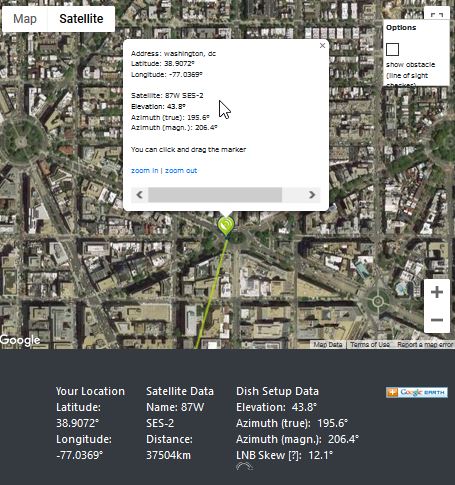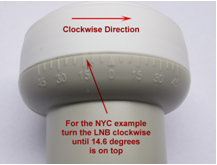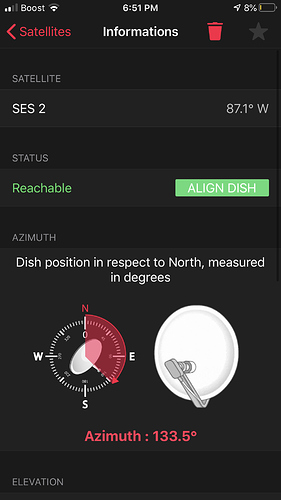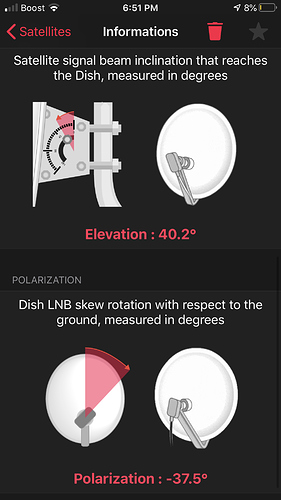Hello all! I’ve done everything right so far to get my system up and running. I’m just having issues with lining up with the satellite. I’m in San Diego, ca.
Make sure you are using skylark 5.8 anything older wont have the updated frequency. Some people had to tweak the frequency a little before they could lock. Are you seeing anything in the status window?
Yes I get info on status but no lock. My issue is with lining up the cone. What method do you use. I use the app on my phone and put my camera behind the cone and line up.
The best way it use an actual compass and a protractor tolls on phones are highly inaccurate
Some folks have found it necessary to change the frequency on the Satellite Tuner Tab from the prescribed 12.1032 MHz to 12.1029 MHz to achieve lock.
However if more presice satellite acquisition is needed, I developed the following method which in in the User’s Manual and on the4 Wiki. Ken - -
Dreamcatcher Satellite Acquisition Guidance
Power up the Dreamcatcher/LNB outside, and point to the satellite. Othernet is on SES-2 on Ku-band North America Beam (87W), and Astra 3B on Ku-band Central and Europe Beam (23.5E).
Based on where you are, find your elevation angle, skew, and magnetic azimuth from a site such as http://www.dishpointer.com . For your first satellite acquisition effort, select a location with a clear unobstructed view of the equatorial sky. (Later, once you confirm your system is working, you can try to find a better more permanent location. Many people are able to operate thru windows or off balconies with partially obstructed views.)

Example: For Washington, DC, mount the LNB on a camera tripod with the appropriate skew angle set to 12.1 degrees clockwise (more on skew below). Using a magnetic compass chose the Azimuth (magn.) to get a sight line on close in objects which you can use to point your LNB towards the satellite at 206.4 degrees magnetic. If you use a cellular phone, you may have to use Azimuth (true) to get the sight line. Use an Adjustable Sliding Bevel and a carpenter’s level to get a precise elevation angle (EA) of 43.8 deg for Washington, DC, set on the LNB. In the picture below, the obtuse angle inside the Adjustable Sliding Bevel is EA + 90 degrees or 43.8 + 90 =133.8 degrees with the vertical side of the Adjustable Sliding Bevel perfectly perpendicular to the ground.

Skew allows you to match your LNB’s horizontal/vertical orientation with the satellite’s horizontal/vertical orientation to maximize signal strength. When you set the skew, make sure you rotate the LNB so that skew angle is pointed directly overhead. Skew is given in degrees either clockwise (CW) or counterclockwise (CCW). If the reported LNB Skew direction for your location is shown clockwise, you stand behind the LNB looking at the satellite and rotate the LNB clockwise until you arrive at that number. For Washington, DC, you set the skew to 12.1 degrees by turning the LNB in a clockwise direction. Viewing the same satellite on the same longitude, but from South of the equator, result in an opposite rotation skew angle.

Skews less than 10 degrees CW or CCW don’t make much difference, but if you live on the far edge of a satellite beam, skews may approach 30 degrees which is significant. If your satellite has a built-in offset as in EU’s Astra 3B, use the Skew that http://www.dishpointer.com provides which is correct.
To get a negative skew do I turn it clockwise?
As part of the tuner I would love to see a scan function added; a waterfall like many amateur radio programs would be ideal but might be difficult to implement as part of a web interface. Even a line graph where we could see peaks for signal would be super helpful especially if a replacement LNB was a bit off freq.
If you can get it pointed in the general area it may be easier to just slowly scan the sky until you get results on the status page. Then you can peak the signal with the snr feedback. Hopefully you dont find yourself in a situation like I am in. I have a signal but no lock. I still haven’t figured out what the problem is.
No - - you are in California, looking at the satellite from behind the LNB you turn it CCW. Ken
Yes, take a look here
not exactly the same but can help in finding the best signal.
The solution used was to tune the dish mounted LNB using a sat-finder at the dish and then verify the correct satellite and transponder RX with a sat-TV receiver. But for those who only have a Dreamcatcher maybe even when using a bare LNB a good scan app would help I think. With the design being final it is not like we will be able to add a satellite finder to the Dreamcatcher, but keeping an inline satellite finder in your kit if you are a pop-up mobile user seems like it might be useful.
When I was setting up my ku band fta dish last fall I found it easier to point my dish with the dreamcatcher then switch to my receiver. Then I had a reference point to find the other satellites. With the dreamcatcher I could be a couple degrees off and still see a signal. With a satellite receiver I would have to be pointed almost perfectly before i could see a signal. The issue with those cheap inline satellite finders is they dont discriminate between satellites.
I like N2YO.com
The web page has about everything you to need to understand satellites. The Othernet is using SES 2
First put in in your location accurately using Lats and Longs and save it. Now look for SES 2. Do not put in SES-2 or SES2, just SES 2. The info you have seen on this topic so far is very good. This is just an FYI.
Good Luck and stay safe
Solved! Getting a lock now! Thanks guys!
That’s what this Forum is all about! No matter what the problem, someone else has seen it - - and someone knows how to solve it  Ken
Ken
this is fantastic information, we may need to revisit.

